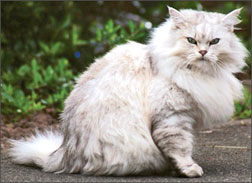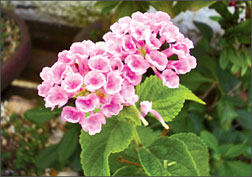|
Flowers & Pets |
Edited by Ruwini JAYAWARDANA |
Just like with people, diabetes is rising in pets
The nine-year-old Australian Terrier was drinking a lot of water and
urinating frequently. So his owner took the little dog to her
veterinarian. A urinalysis and blood work revealed that he had diabetes.
 As with people, the incidence of diabetes in cats and dogs is
increasing. Not so much of a problem in decades past, diabetes now
affects as many as one in 50 of the animals, some statistics show,
especially pudgy pets. As with people, the incidence of diabetes in cats and dogs is
increasing. Not so much of a problem in decades past, diabetes now
affects as many as one in 50 of the animals, some statistics show,
especially pudgy pets.
Diabetes results when the body doesn’t produce enough insulin, a
hormone that processes glucose (blood sugar), or properly use it. As a
result, the body’s tissues cannot use glucose for energy, and the sugar
builds up in the blood and urine.
Veterinarians say that while obesity clearly is linked to diabetes in
pets, it appears to contribute to the disease differently in cats and
dogs.
Fat cats are prone to diabetes because they develop insulin
resistance, meaning their bodies do not effectively use insulin. As a
result, the pancreas pumps out more insulin as well as another hormone
called amylin.
“When you get too much insulin secreted, you get too much amylin
secreted as well, and that tends to aggregate and destroy the
insulin-producing cells,” says veterinarian Richard W. Nelson, a
professor at the University of California School of Veterinary Medicine
in Davis.
 With dogs, obesity is associated with an increased risk of
pancreatitis - an inflammation of the pancreas - which can then lead to
diabetes because the body does not make enough insulin. With dogs, obesity is associated with an increased risk of
pancreatitis - an inflammation of the pancreas - which can then lead to
diabetes because the body does not make enough insulin.
Not every dog or cat that develops diabetes is fat, but any way you
look at it, obesity and diabetes are linked. The good news is that
obesity is preventable and reversible, and oftentimes so is the
diabetes.
A change to a high-protein, low-carbohydrate diet - nicknamed the
“Catkins” diet - can promote weight loss and make diabetes more
manageable in cats, often sending them into remission so that they no
longer require insulin injections. At the Windsor Veterinary Clinic in
Colorado, three out of every four diabetic cats have their disease
controlled through diet alone.
Diet can help manage the disease in dogs so that they need less
insulin, but it does not have as dramatic an effect as it does in cats.
Besides diet, improvements in insulin have made it easier for owners
to manage diabetes in dogs and cats. Veterinarians now have two newly
approved forms of insulin, one for cats and one for dogs, that make
treatment better.
Vets also are finding that some diabetic cats respond well to a
long-acting human synthetic insulin called glargine, which appears to
work best in newly diagnosed diabetic cats that are being fed a
high-protein, low-carb diet.
Another important development has been the ability of owners to check
a pet’s blood glucose level at home using a blood glucose meter. That
makes it a lot easier to ensure that a pet is receiving the right amount
of insulin, without subjecting it to a stressful overnight stay at a
veterinary clinic.
Flowers of Sri Lanka:
Applying hormones on the stem
Manoj DISSANAYEKE
 Normally there is no need to apply hormones on the stems of plants
that can be obtained easily. However it is essential to apply the
mixture on species like Bougainvillaea, Cyprus, and Ixora since this
sends a message to the sampling to form roots in the stem. It also
provides safety from certain fungal diseases. Normally there is no need to apply hormones on the stems of plants
that can be obtained easily. However it is essential to apply the
mixture on species like Bougainvillaea, Cyprus, and Ixora since this
sends a message to the sampling to form roots in the stem. It also
provides safety from certain fungal diseases.
Some believe that the stems will form roots and propagate into a new
plant simply by the use of the hormonal liquid. This is not true as
there are other essential facts needed for this process.
There are two forms of root forming hormones available in the market.
They are:
* Liquid forms (similar to jelly)
* Powder form
 The liquid form evaporates much quicker than the powder. Therefore it
is not suitable for propagation during a humid climate. The liquid form evaporates much quicker than the powder. Therefore it
is not suitable for propagation during a humid climate.
When you apply the powder form, collect the powder onto a piece of
paper. Then take the stem cutting and carefully rub the cut surface of
the stem on the powder.
If you think there is too much powder on the cutting, tap the stem
gently with your finger. Some people believe that plants will bloom
twice as much if you apply more hormones. This is a false belief. The
stem will rot if too much hormones are applied.
Another drawback in using hormones is that it has negative affects
towards our nervous system. Therefore take care when you handle these
chemicals and powders.
Planting the stem cutting
After applying the hormone chemical the stem should be planted in a
polythene bag filled with the medium. Water the medium. Then take a
stick and form a circle in the middle of the medium. Push the stem into
this circle and tighten the medium around the stem with your hands.
Normally a stem should be covered with the medium at least one inch
deep from the lower sampling. So do not water the plant at this stage as
the hormones might be washed away.
Think back. There may be instances where you were unable to obtain a
new plant due to some small mistakes from your part. Follow these steps
carefully and you may achieve surprising results.
(The writer is the Agriculture Instructor of Royal Botanical Gardens,
Peradeniya)
|

